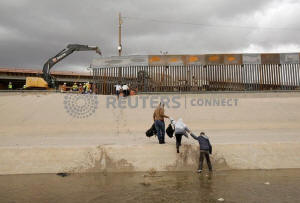|
On U.S. border, fence meant as barrier
becomes lure for migrants
 Send a link to a friend
Send a link to a friend
 [March 08, 2019]
By Andrew Hay, Lucy Nicholson and Jane Ross [March 08, 2019]
By Andrew Hay, Lucy Nicholson and Jane Ross
EL PASO, Texas (Reuters) - Huddled against
a border fence on a bitterly cold morning in El Paso, Texas, a group of
60 Guatemalan migrants, around half toddlers and children, shouted for
help: "We're cold, we're hungry, we need shelter."
The group was trying to surrender to U.S. Border Patrol agents and claim
asylum, but the agents were too busy herding other groups along the
fence that stands about 100 yards (91 m) inside U.S. territory.
The 18-foot-high (5.5 meters) steel barrier is meant to deter illegal
immigration. But its position inside the border has turned it into a
destination for human smugglers trafficking large groups of asylum
seekers fleeing poverty and violence.
The smugglers in recent weeks have shifted routes to El Paso from the
remote Antelope Wells area of New Mexico, Border Patrol supervisory
agent Joe Romero said.

Once undocumented migrants are on U.S. soil, the Border Patrol is
obliged to arrest them for entering illegally. But migrants can claim
fear of returning to their countries, allowing them to remain in the
United States legally until an asylum hearing, which can take months or
years.
The smugglers' strategy exploits a weakness in the very border wall
President Donald Trump has touted as a means to protect the United
States from undocumented immigrants and illicit drugs.
The crowds in El Paso illustrate changing immigration patterns. As
recently as 2015, the majority of undocumented border crossers were
adult men from Mexico looking to disappear into the country and find
work. Now the Border Patrol says about 85 percent of migrants arriving
in the El Paso sector are Central American families and children seeking
asylum.
Gaspar Isom, 38, who was with his 16-year-old son Sebastian, said he
chose El Paso for the relative safety of its sister Mexican border city,
Ciudad Juarez.
"We were told other places were more dangerous to cross, they were
controlled by the Zetas," Isom said, referring to the Mexican cartel.
[to top of second column]
|

Migrants cross a river next to an excavator working in a section of
the new wall between El Paso, Texas, in the United States and Ciudad
Juarez as seen from the Mexican side of the border in Ciudad Juarez,
Mexico, February 5, 2019. REUTERS/Jose Luis Gonzalezz

The pair were among close to 1,000 mostly Central American migrants
who crossed into El Paso on Wednesday in the kind of surge the U.S.
border has not seen in over a decade, Border Patrol data show.
El Paso is not alone in seeing an uptick. Over 268,000 undocumented
migrants were arrested at the Southwest border from October through
February, a near doubling over the same period a year earlier, to a
12-year high, according to government data released this week.
Annual apprehensions remain well below the peak of 1.6 million in
2000.
Border Patrol officials say the El Paso fence, one of multiple
sections of barrier built inside the border due to quirks of local
topography, is successful in stopping migrants from scattering into
El Paso.
But they acknowledge having a hard time keeping up with the numbers.
El Paso sector Border Patrol stations reached capacity on Wednesday,
and the group of 60 was finally picked up at 5 a.m. Thursday, after
spending two nights sleeping by the fence, according to Dylan
Corbett, who helps run a migrant shelter operated by El Paso's Roman
Catholic diocese.
Romero said the agency ran out of space to safely and securely
transport migrants: "We have manpower shortages, our facilities are
at capacity if not more."

(Reporting by Andrew Hay, Lucy Nicholson and Jane Ross; Editing by
Scott Malone and Leslie Adler)
[© 2019 Thomson Reuters. All rights
reserved.]
Copyright 2019 Reuters. All rights reserved. This material may not be published,
broadcast, rewritten or redistributed.
Thompson Reuters is solely responsible for this content. |